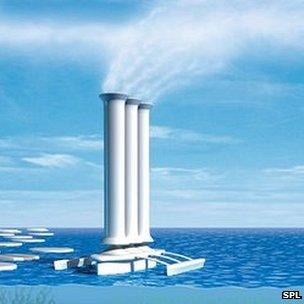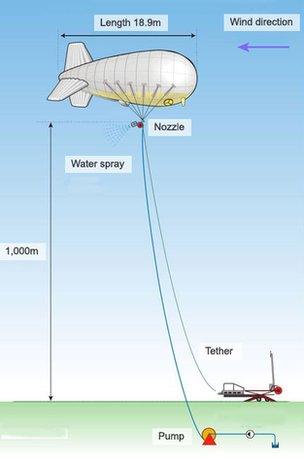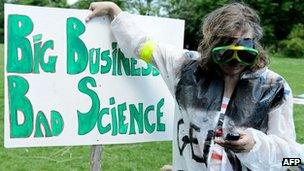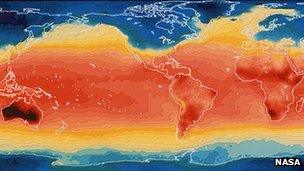Geoengineering: Risks and benefits
- Published
- comments

Cloud-whitening - geoengineering, or not?
Few issues arouse as much controversy in environmental circles these days as geoengineering, external - "technical fixes" to tackle climate change, by sucking carbon dioxide from the air or by reducing the amount of sunlight hitting the Earth.
And here's why.
If Planet Earth is facing a climate "emergency", as some people believe we are, then we should leave no option for combating it unexplored, they argue.
While very few scientists advocate deployment of geoengineering now, many believe we ought to be getting on with research now in order to have technologies ready in 10-20 years when they might be needed.
On the other hand, many environment groups and some scientists argue that diverting attention and research funds towards geoengineering means people will take their eyes off the more important tasks of reducing greenhouse gas emissions and adapting to climate impacts.
Some also argue that politicians and the public will see geoengineering research going on and believe it constitutes a "get-out-of-jail-free" card, reducing the incentive to cut emissions.
Add in the fact that the easiest technical fixes might constrain temperatures but won't tackle the problem of ocean acidification, and you have a rich cocktail of scientific, economic and social issues to discuss.
The arguments were on display this week in a symposium at Oxford University, which recently set up a multi-disciplinary research programme, external on the issue.

The SPICE test would have pumped out water droplets 1km above the ground
Present were not only physical and social scientists but officials from government departments and funding agencies, representatives from environmental groups and a few journalists.
The hottest current issue in UK geoengineering is the SPICE project, external.
Its most obvious component, the deployment of a tethered balloon to disperse water into the air, was postponed and probably cancelled earlier this year when some of the team found out that a patent had been lodged on some of the technology.
What was most interesting in the SPICE-related discussions, however, was the question of whether the balloon should be deployed or not.
It's basically a technology test. Researchers want to gather data that could potentially be used in future to make much bigger systems capable of spraying tiny sulphate aerosol particles into the upper atmosphere, mimicking the cooling effect of volcanic eruptions.
The team, led by Matt Watson of Bristol University and Hugh Hunt of Cambridge, have repeatedly stressed that they don't advocate doing this yet and perhaps never will advocate it; they just want the technology to be ready in case it's needed.
Clearly, the SPICE balloon itself would have no climatic impact. Even so, a number of environmental groups lobbied against the research, for reasons enumerated above, with one, the ETC Group, dubbing it the "Trojan Hose", external.
They and others advocate a tough international regime for all research that would permit laboratory studies but prevent anything happening in the real world.
Others say that's far too draconian, and point to what appears to be the self-contradictory stance of some groups opposing genetically engineered crops - to say there's no research proving they're safe, but then to trash research projects that could provide the proof.

Could geoengineering research be blocked, even when it might prove safety?
For example, it was pointed out, spraying sulphate particles into the stratosphere might ruin the ozone layer. You'd want to know that before you contemplated using the technology; but how are you going to find out unless you spray a little bit?
Some rules already exist.
By far the most researched technology is ocean fertilisation, where iron is used to stimulate plankton growth in the ocean, increasing uptake of carbon dioxide. Something like 12 large-scale projects have been carried out, with mixed results.
From the regulation point of view, it's also the most advanced field, with the London Convention, external having agreed rules in recent years that restrict research on the basis of its potential utility and potential risks.
Commercial interests are forbidden, countries must "use utmost caution and the best available guidance to evaluate the scientific research proposals to ensure protection of the marine environment". Deployment - as opposed to research - is not allowed.
Elsewhere, the UN Convention on Biological Diversity in 2010 agreed, external that for now, "no climate-related geoengineering activities that may affect biodiversity take place... with the exception of small scale scientific research studies... and only if they are justified by the need to gather specific scientific data and are subject to a thorough prior assessment of the potential impacts on the environment".
The ETC Group and others describe this as a "moratorium" on geoengineering. But it isn't a complete one, as much geoengineering research, even on a large scale, would have no impact on biodiversity...
... whereas climate change, of course, will.

Some argue failure to constrain carbon emissions mean we will need "tech fixes" soon
If the situation weren't complex enough, another issue's arisen lately - what you might call "dual-use" research.
More than 10 years back, I talked to a US scientist just back from an iron fertilisation experiment who explained that personally, he wasn't interested in geoengineering; really, he wanted to answer more academic questions about iron distribution in the water and derive answers about what the oceans used to look like in the past.
He dressed the funding proposal up in geoengineering language because that was the way to get funds - a tactic scientists in all fields have used down the years in order to ensure their research happens (witness the boom in "bioterror"-related research, external after the US anthrax scares of 2001, external).
Fast-forward to the present, and we're seeing the opposite phenomenon - research that could give geoengineering answers, but isn't labelled as such.
Last year, US scientists ran a project on the behaviour of aerosols in clouds.
Such research is standard; what was new about the E-Peace project, external was the inclusion of "controlled release and atmospheric distribution of three different size ranges of [aerosol] particles in flight and on or by a dedicated ship".
Geoengineering research by another name?
Now, a UK team is proposing, external "seeding" clouds out at sea to control hurricane strength, and perhaps stop them forming at all.
Clouds would be sprayed with minuscule droplets of seawater. This would make them whiter so they reflect more sunlight back into space, reducing the sea surface temperature - which is the primary driver of hurricanes.
Other researchers, including the UK's Stephen Salter, are proposing using the same apparatus to whiten clouds in order to reflect sunlight and cool the world; in another word, geoengineering.
So when some argued in Oxford that research should be constrained if it's tailored towards geoengineering but permitted if it's not, I wondered: how?
What you might regard as an optimistic note is the degree of thought and debate that's going into the issue of how to regulate geoengineering research before it happens.
Nothing like this went into other controversial but important issues such as genetically engineered crops, shale gas or nuclear power before it began.
But whatever rules are eventually developed, one suspects they're going to have to be applied with common sense.
In 1997, while making a radio series on climate change, I went to a roof-whitening ceremony in Miami.
Attended by marching bands and flags and encouraged by a district mayor, the good burghers of several streets were painting their roofs white, to reflect sunlight and cool the Earth.
They were deploying geoengineering. As far as I know, the world is still turning.